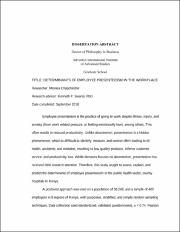Determinants of employee presenteeism in the workplace
Abstract
Employee presenteeism is the practice of going to work despite illness, injury, and anxiety (from work related pressure, or feeling emotionally low), among others. This often results in reduced productivity. Unlike absenteeism, presenteeism is a hidden phenomenon, which is difficult to identify, measure, and control often leading to ill-health, accidents, and mistakes, resulting to low quality products, inferior customer service, and productivity loss. While literature focuses on absenteeism, presenteeism has received little research attention. Therefore, this study sought to assess, explain, and predict the determinants of employee presenteeism in the public health sector, county hospitals in Kenya.
A positivist approach was used on a population of 58,248, and a sample of 400 employees in 8 regions of Kenya, with purposive, stratified, and simple random sampling techniques. Data collection used standardized, validated questionnaires, α = 0.74. Pearson
correlation analysis revealed a significant relationship between work pressure, r = .68, p < .05; job insecurity, r = .78, p < .05; work policies, r = -.763, p < .05; positive supervisor behavior, r = -.592, p < .05; negative supervisor behavior, r = .592, p < .05; conscientiousness, r = -.325, p < .05; extraversion, r = .536, p < .05; and employee presenteeism. Multiple linear regression analysis generated a five predictor model accounting for 71.9% of the variance in employee presenteeism, normally shown as R2. The model is a good fit for data as it significantly predicts employee presenteeism, p < 0.05. Job insecurity is the best predictor of employee presenteeism (β = .377), followed by work pressure (β = .277), extraversion (β = .241), work policies (β = -.211), and negative supervisor behavior (β = -.104).
Findings demonstrate that employee presenteeism is a real workplace challenge that requires real solutions through policy interventions. The study adds new knowledge and provides that work/organizational and personal factors significantly predict employee presenteeism. Also, sickness presence prevalence was high during the last 12 months while sickness absence was low indicating that employees attended work despite illness, injury, or low emotional feeling. Further, work pressure, job insecurity, supervisor behavior, work policies, conscientiousness, and extraversion were significantly associated with employee presenteeism. Finally, the predictive model of employee presenteeism adequately explains employee’s choice to attend work or not when feeling unwell. Therefore, in order to manage employee presenteeism, the researcher recommends increased awareness programs, employees’ well-being strategies, interpersonal relations, training, and fair implementation of work policies to inspire goodwill mentality for both employer and employee and increase productivity.


